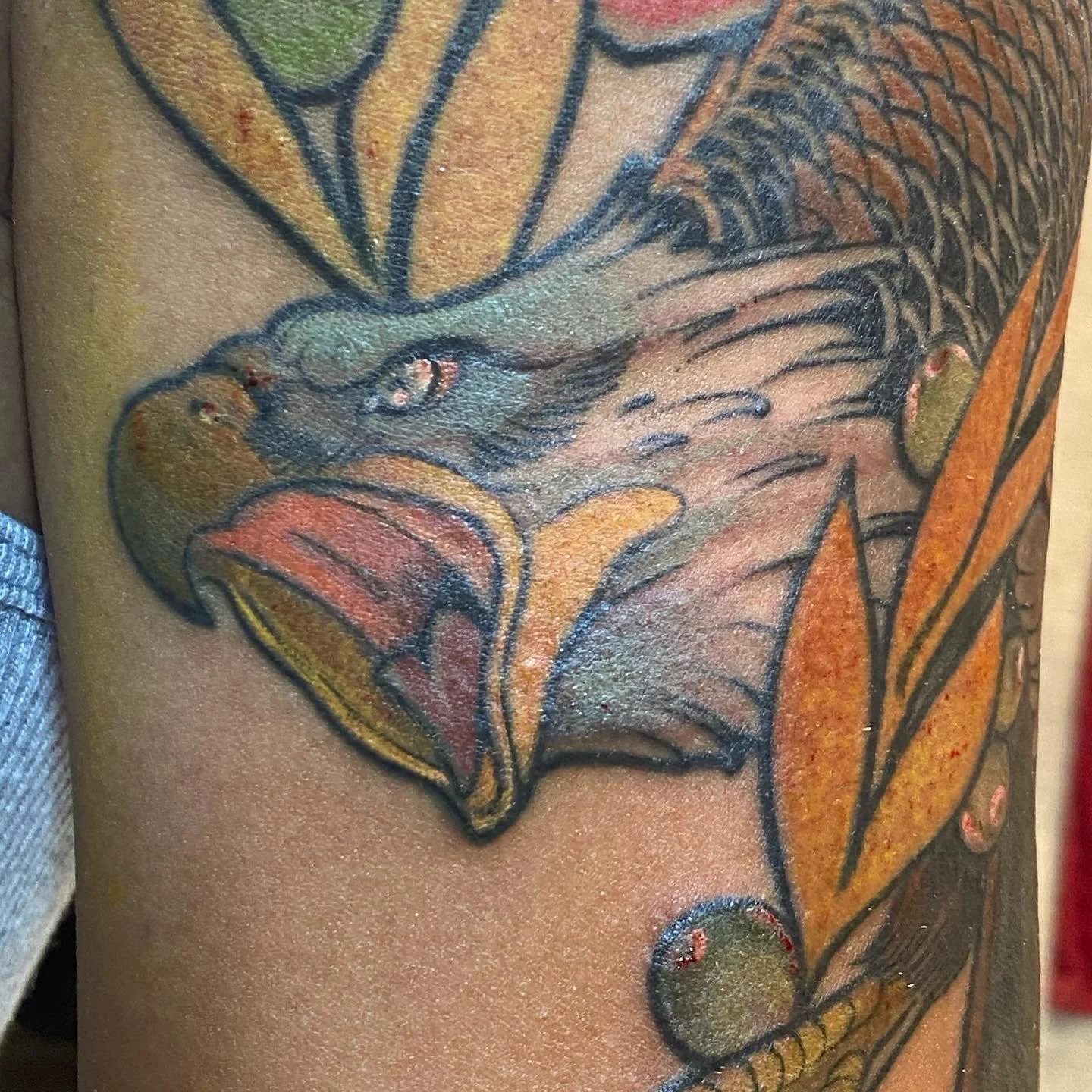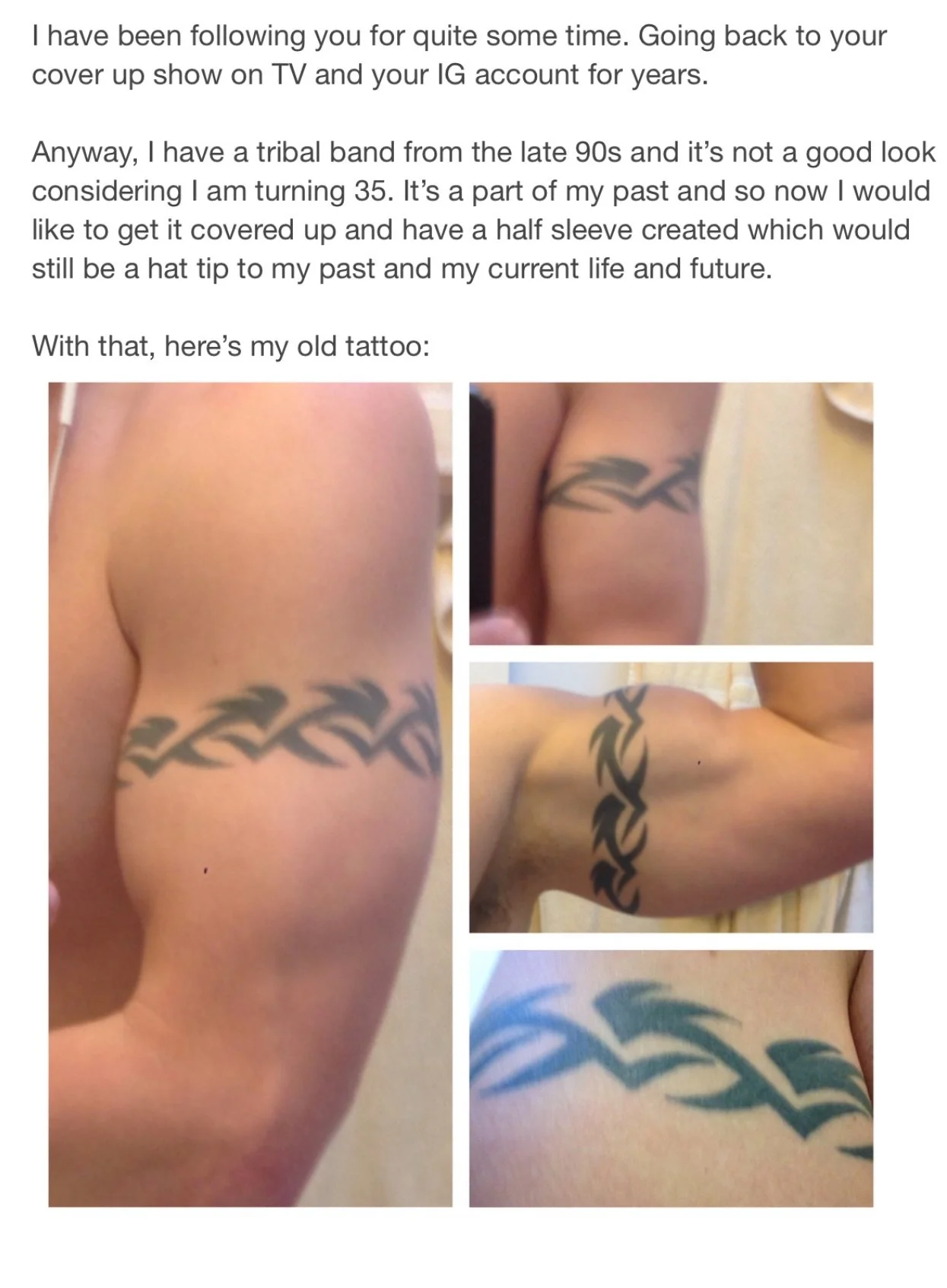Bird Tattoos: Freedom, Flight, and the Stories They Carry
Why I Love Tattooing Birds
Neotraditional swallow with arrows
I’ve always loved tattooing birds — not just because my last name is Swan, but because there’s something endlessly fascinating about wings. The way they fold, layer, and move through space gives them so much depth and life. Every feather tells a story of motion, freedom, and transformation. Birds are a perfect balance of structure and grace — which makes them not only beautiful to tattoo, but incredibly versatile.
They also happen to make some of the best cover-ups you can do. The layering of feathers, the natural flow of wings, and the opportunity for bold color and movement allow me to completely reinvent a space on the body. When you need to erase or evolve an old tattoo, a bird — whether it’s an eagle, swallow, hummingbird, or something more exotic — is often the perfect choice. It’s symbolic of renewal, rebirth, and rising above the past — exactly what a good cover-up should represent.
Swallows & Sparrows — The Return Home
neotraditional swallow
neotraditional swallow
Classic swallow tattoos, like the ones sailors wore, are some of the oldest motifs in traditional tattooing. They symbolize safe return, loyalty, and freedom — marking miles traveled and lives survived.
In these designs, the bold outlines and limited color palette are intentional — a nod to American Traditional style. You will notice in my work that I take a modern approach to traditional tattooing. Adding a bit of delicate line work or using a more organic and natural shape of the bird while still maintaining a traditional approach. These tattoos age beautifully because they’re built to last. The simplicity in linework and color keeps them striking and readable decades later. They represent resilience, devotion, and the spirit of adventure — all wrapped up in one small, powerful bird.
Hummingbirds — The Spirit of Resilience
hummingbirds done with an element of realism
Hummingbirds are pure motion — tiny hearts beating faster than you can see. In tattoo form, they represent joy, endurance, and the will to keep moving forward. They’re also deeply symbolic of healing and balance, hovering between fragility and strength.
When I tattoo hummingbirds, I often lean toward a more elegant and realistic style to capture their iridescent glow and delicate anatomy. They’re light, alive, and full of emotion — and that makes them just as beautiful as they are symbolic.
The American Eagle — Freedom and Strength
Outline of eagle. See the old lettering and banner that we are covering.
black and grey chest eagle used to cover up an old tattoo.
Few images are as iconic as the eagle. It’s been part of tattoo history since the early 1900s, carried by veterans, bikers, and patriots alike. The American Eagle symbolizes freedom, courage, and loyalty — both to one’s country and to one’s own sense of self.
In tattoo form, the eagle is pure power: wings wide, talons out, eyes locked. The bold geometry of traditional American tattooing gives it authority, while black-and-gray versions take on a more timeless, stoic feel. It’s a design that bridges eras — honoring classic flash traditions while embodying the independent spirit of modern tattooing. The eagle will always stand for strength, pride, and the power to rise above.
Screaming eagle
Hawks and Birds of Prey — Focus and Fearlessness
Powerful hawk with Japanese elements
Hawks, falcons, and other raptors are about precision and perspective — sharp eyes, sharp claws, and unstoppable drive. They symbolize dominance, vision, and the ability to strike when the time is right.
Artistically, these pieces often blend neotraditional and hyper-traditional styles, combining bold outlines with painterly gradients and dramatic movement. The result is something that feels alive — wings spread, talons reaching, a moment frozen in flight.
Black and Gray full frontal hawk
The Mexican Eagle — Heritage and Honor
Traditional Mexican Flag Coat of arms
The Mexican coat of arms — an eagle devouring a serpent atop a cactus — is more than just an image. It’s identity, ancestry, and strength. It represents triumph over adversity and the deep cultural pride that connects generations.
Rendered with bold lines, textured feathers, and deep, earthy tones, this kind of tattoo honors both Chicano tattoo heritage and the national symbol of Mexico itself. It’s storytelling in motion — a living emblem of courage and resilience.
The Bluebird — Hope and Heartbreak
No bird carries more quiet emotion than the bluebird. It’s long been a symbol of happiness, hope, and the freedom to be yourself — but there’s always something tender about it too.
Charles Bukowski captured it perfectly in his poem “Bluebird”:
“There’s a bluebird in my heart that
wants to get out,
but I’m too tough for him…”
Bukowski’s bluebird isn’t just about joy — it’s about the softness we hide beneath our armor. A bluebird tattoo often reflects that inner light we protect — the part of us that still believes in love, wonder, and the possibility of flight after heartbreak.
Different Wings, Same Sky
Every bird tells a story — not just of flight, but of what it takes to lift off. Whether it’s a swallow carrying the spirit of home, a hummingbird balancing beauty and endurance, or an eagle breaking through the clouds of adversity, each one speaks to our shared longing for freedom.
Across styles — from bold American Traditional to fine-lined realism — bird tattoos remind us that strength and grace can coexist. They’re symbols of resilience, transformation, and the unbreakable will to move forward.
I think Bukowski was right… and maybe that’s what every bird tattoo really is: that hidden bluebird inside us finally finding its wings.
Cover-Up Resurrection: From Regret to Masterpiece
Cover-Up Resurrection: From Regret to Masterpiece
by J. Swan, Broken Art Tattoo – Los Angeles
There’s something intimate, something raw, about stepping into that exact moment when someone decides they no longer want to wear the ghost of a bad tattoo. I’ve spent years doing this work — pulling the old, worn regret into the light, then building something new from those lines, those scars of ink. And yes: I took that skill all the way to the set of America’s Worst Tattoos.
My Time on the Show
When I walked into the studio for America’s Worst Tattoos, I already knew: this wasn’t just a TV-moment, it was real life for someone. The bad job they’d lived with. The embarrassment, the hiding, the desire for something better. The show gave a platform to those stories — and gave me an opportunity to showcase what I do best: see into the old tattoo, follow its rhythm, and turn it into something badass.
Here’s an episode (10:51 min in) that shows the kind of transformations I was doing:
You’ll see the before-wound of regret and the after relief. That’s what I live for.
How I Approach Cover-Ups
Most artists treat the old tattoo like its not even there. Resulting in the old tattoo peering through the new one… But I don’t. I look into it.
I trace the old lines wherever possible — not because I’m copying them, but because they tell a story. They tell me where the ink ran thin, where the client’s regret is etched in skin.
I examine the old shading and texture: faded grey, sloppy gradients, scar tissue. I ask: can I utilize that value for a new dark component, a new shadow, a new flow?
Then I map the new piece: how does it flow on the client’s body? How does it hide the old and elevate the new? I design so the old tattoo becomes part of the composition — a hidden strength.
For example: I had a client with a faded tribal band that wrapped awkwardly around the bicep. It was dated and poorly executed. I traced the heavier line of the tribal band, used it as the motion for waves and water that had a clipper ship sailing into the sunset. All done in black and grey. The old band became the hidden “crest” of the wave — a structural anchor. The shading from the old ink contributed value under the water’s dark tones. What had been a mistake turned into a feature.
Here was the original email he sent me:
Old tribal armband that screams frat boys gone wild
What’s an artist to do? Let the results speak for themselves:
Why This Works
Respect for what’s there: The client isn’t just erasing their past—they’re reclaiming it. I show them the value of where they’ve been.
Efficiency: Using existing ink and scar patterns means less work is wasted. I build on top of what’s there rather than constantly fighting it.
Artistic depth: The old tattoo gives me texture, variation, story. That’s gold. Most new pieces start from a white canvas. But in cover-ups, the canvas is already scarred — and I love that.
My Studio Vibe at Broken Art Tattoo
Since 2005, Broken Art Tattoo has been about transforming skin into stories. In The Heart of Atwater Village, Los Angeles, we’ve created a space where clients come not just for a tattoo, but for reclamation. The dude who got sloppy in his 20s, the woman who wants to hide the ex’s name, the collector whose old work doesn’t reflect who they are anymore — I see them. I listen. Then I ink.
When you walk through our doors you’ll hear the hum of the machines, see the art on the walls, feel the hustle of L.A. culture. But you’ll also feel the quiet of someone who’s about to wear something that means something new. That’s the moment I live for.
Ready for Your Cover-Up?
If you’re sitting there looking at your reflection, thinking “I wish that tattoo never happened” — don’t. Let’s turn it into something that does happen. Send me a photo of your old piece, tell me the story you want now. I’ll see the old lines. I’ll see the shading. I’ll see the art buried in regret. Then we’ll design something that sets you free.
Book your consultation at Broken Art Tattoo. Let’s reclaim your skin and write a new chapter. Text me today 323-612-7886
Tribal Redemption: From Blackout to Tibetan Dragon
It all begins with an idea.
What started as a solid black half-sleeve and chest panel of old tribal work became one of the wildest cover-up transformations I’ve ever done. This kind of project takes time, patience, and precision — and it’s all about trusting the process.
To conquer a full-black tribal piece, you’ve got to start with bold, confident linework. I map new structure right over the old — Tibetan skull outlines, dragon flow, background motion. Then I add strategic shading to break up the solid black. This is where the old tattoo starts losing power and the new form begins to emerge.
Here’s where the magic starts happening. I use a white-out pass over the old black ink, layering titanium white directly into the dark fields. That step creates an opaque barrier and opens the door for future color. It’s not instant gratification — the skin needs about a month to heal before we can go back in. But this move is the secret weapon that lets me transform blackout tribal into color realism.
Once the skin’s ready, I dive back in for the final pass — complete color saturation. The Tibetan skull explodes to life, the dragon coils across the chest, and the original tribal is gone — absorbed, transformed, reborn. It’s an insane cover-up that proves no tattoo is too dark or too far gone when you’ve got the right vision and patience.
This is what I love about cover-ups: it’s not about hiding the past — it’s about rebuilding from it. Every line, every shade of black, every scar becomes part of the story.






















